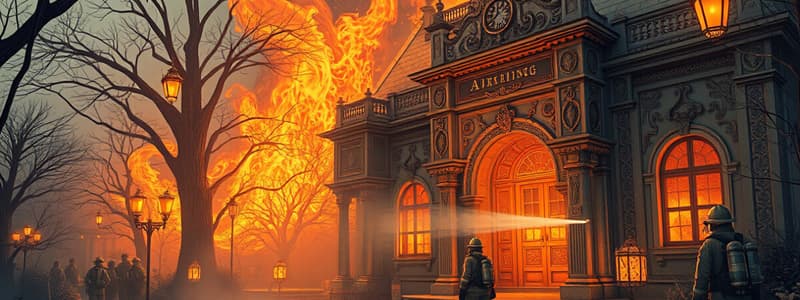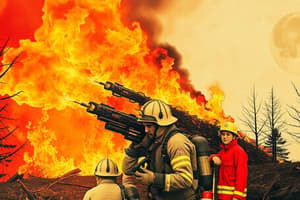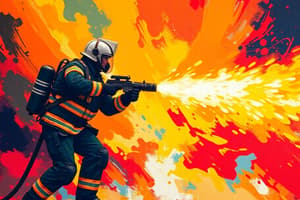Podcast
Questions and Answers
What primarily influences line placement in occupied buildings?
What primarily influences line placement in occupied buildings?
- The age of the building
- The financial value of the property
- The presence of life hazards (correct)
- The proximity to fire stations
In the absence of life hazards, what should guide placement decisions?
In the absence of life hazards, what should guide placement decisions?
- The property value and insurance costs
- Current building codes and regulations
- Accessibility for emergency services
- Potential for extension and protection of exposures (correct)
What is the primary danger of attacking a fire from exterior windows?
What is the primary danger of attacking a fire from exterior windows?
- It is ineffective for heavy fires.
- It causes quick water depletion.
- It limits visibility for firefighters.
- It can push fire, heat and gases into the structure. (correct)
When is it crucial for firefighters to get water on the fire as soon as possible?
When is it crucial for firefighters to get water on the fire as soon as possible?
What should be done if there is significant wind blowing the fire towards the firefighters?
What should be done if there is significant wind blowing the fire towards the firefighters?
If it is less punishing for the FFs then where should you attack a vacant building fire?
If it is less punishing for the FFs then where should you attack a vacant building fire?
What is the primary consideration when deciding between offensive and defensive operations during a fire response?
What is the primary consideration when deciding between offensive and defensive operations during a fire response?
If the fire is already large, what is the recommended action regarding the first attack line?
If the fire is already large, what is the recommended action regarding the first attack line?
What factor is considered third in the sequence of decision-making for fire response?
What factor is considered third in the sequence of decision-making for fire response?
What does the fourth factor have to do with?
What does the fourth factor have to do with?
Why is it generally preferable to stretch a hoseline immediately to the fire on upper floors?
Why is it generally preferable to stretch a hoseline immediately to the fire on upper floors?
Why is it critical to know how quickly additional hoselines can be deployed during a fire?
Why is it critical to know how quickly additional hoselines can be deployed during a fire?
What is often a necessary approach when dealing with a fire on the third floor or higher?
What is often a necessary approach when dealing with a fire on the third floor or higher?
Which factor is considered the most significant threat to exposures from a fire?
Which factor is considered the most significant threat to exposures from a fire?
How does the distance between structures affect the threat of radiant heat?
How does the distance between structures affect the threat of radiant heat?
Why is venting fire out of a window in a brick wall less concerning compared to frame structures?
Why is venting fire out of a window in a brick wall less concerning compared to frame structures?
What are the primary priorities in firefighting?
What are the primary priorities in firefighting?
How can a firefighter regain control if they have lost it due to water flow?
How can a firefighter regain control if they have lost it due to water flow?
What does narrowing the area in a nozzle achieve?
What does narrowing the area in a nozzle achieve?
If the fire is on the ___ floor or above it is nearly always more efficient to stretch immediately to the fire pg 78
If the fire is on the ___ floor or above it is nearly always more efficient to stretch immediately to the fire pg 78
After __ -__ seconds of water application the nozzle team should be alert for signs that they have achieved this knockdown and then start to reposition their line
After __ -__ seconds of water application the nozzle team should be alert for signs that they have achieved this knockdown and then start to reposition their line
When making a decision to commit the first line to interior ops or as exposure protection consider: 1 first factor is always life hazard, 2 is ___ of the fire. 3 attack ____ of the unit 4 the ____ of the buildings, particularly the siding
When making a decision to commit the first line to interior ops or as exposure protection consider: 1 first factor is always life hazard, 2 is ___ of the fire. 3 attack ____ of the unit 4 the ____ of the buildings, particularly the siding
Flashcards
Transitional Attack
Transitional Attack
Applying water to a fire from outside a building before entering, prioritizing exposures and occupant safety.
Fire Location Assessment
Fire Location Assessment
Determining fire's location and potential threats to people or property before deploying water.
Exterior Hoseline Placement
Exterior Hoseline Placement
Position hoses between fire and people or to protect exposures.
Fire Size and Initial Attack
Fire Size and Initial Attack
Signup and view all the flashcards
Upper-Floor Fire Attack
Upper-Floor Fire Attack
Signup and view all the flashcards
Hoseline Deployment Time
Hoseline Deployment Time
Signup and view all the flashcards
Exterior Water Application
Exterior Water Application
Signup and view all the flashcards
Initial Water Application Duration
Initial Water Application Duration
Signup and view all the flashcards
Egress Threat Attack
Egress Threat Attack
Signup and view all the flashcards
Arson Suspected Attack
Arson Suspected Attack
Signup and view all the flashcards
Windy Conditions Attack
Windy Conditions Attack
Signup and view all the flashcards
Exposure Protection Priority
Exposure Protection Priority
Signup and view all the flashcards
Hoseline Placement Evaluation
Hoseline Placement Evaluation
Signup and view all the flashcards
Limited Hose Diameter
Limited Hose Diameter
Signup and view all the flashcards
Large Diameter Lines
Large Diameter Lines
Signup and view all the flashcards
Window Openings & Fire Energy
Window Openings & Fire Energy
Signup and view all the flashcards
Radiant Heat Risk
Radiant Heat Risk
Signup and view all the flashcards
Building Construction Impact
Building Construction Impact
Signup and view all the flashcards
Rescue, Confinement, Extinguishment
Rescue, Confinement, Extinguishment
Signup and view all the flashcards
Radiant Heat Mitigation
Radiant Heat Mitigation
Signup and view all the flashcards
Nozzle Functionality
Nozzle Functionality
Signup and view all the flashcards
Nozzle Use in Fire Control
Nozzle Use in Fire Control
Signup and view all the flashcards
Study Notes
Transitional Attack
- Transitional attack involves applying water directly to burning areas from outside a building before transitioning to interior attack.
- Critical to assess the fire's location and potential threats to life or exposures before deciding on the first hoseline's position.
- Place hoselines between the fire and any occupants, or aim to protect exposures when necessary.
Factors for Decision-Making
- Consider if the volume of fire is too large for initial hoseline extinguishment, requiring a holding position for exposure protection.
- If fire is on upper floors, hoselines should be stretched to the location of the fire rather than taking longer routes through the structure.
- Knowledge of how quickly additional hoselines can be deployed informs strategy selection.
Firefighting Considerations
- Using exterior streams is beneficial for quick knockdown but is unlikely to achieve complete extinguishment.
- Initial water application should be brief (15-20 seconds) to avoid trapping firefighters in smoke and heat.
- Attack the fire immediately in areas that threaten egress, especially when there's arson suspected or in hazardous locations.
- Avoid attacking from the unburned side in the presence of wind, as this can lead to dangerous conditions for firefighters.
Exposure Protection Strategies
- Protecting the most severe exposure is crucial when life hazards are not present.
- Evaluate the extent of the fire and the attack capability of firefighting units to decide on hoseline placement.
Hoseline Selection and Positioning
- Firefighters with limited hose diameter may focus on exposure protection rather than interior attacks.
- Large diameter lines and master streams significantly enhance firefighting capabilities against major threats.
Factors Impacting Exposure Threats
- Size and proximity of window openings amplify fire energy; targeting windows with effective techniques can help manage threats.
- Radiant heat poses a significant risk, necessitating adequate distancing from the fire source to protect exposures.
- Fire behavior varies depending on building construction; frame structures are particularly susceptible to rapid fire spread.
Prioritize Rescues and Fire Control
- Employ a systematic approach of rescue, confinement, and extinguishment during firefighting operations.
- Be vigilant of radiant heat and properly direct water streams to mitigate risks from unseen ignition sources.
Nozzle Functionality and Management
- Nozzles facilitate water management, allowing regulation of flow and pressure during firefighting efforts.
- Proper use of nozzles can enhance fire control and ensure adequate application to threatened surfaces.
Studying That Suits You
Use AI to generate personalized quizzes and flashcards to suit your learning preferences.



